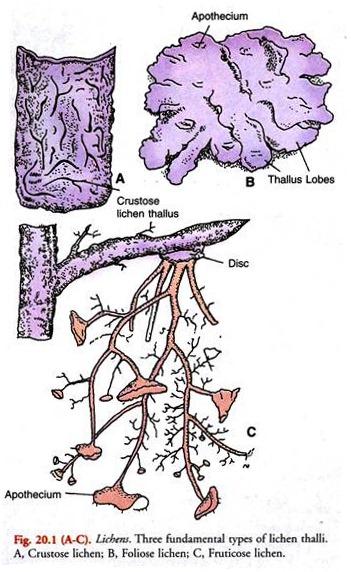ADVERTISEMENTS:
The following points highlight the four main types of lichen thallus. The types are: 1. Crustose (Crustaceous) Lichens 2. Foliose (Foliaceous) Lichens 3. Fruticose Lichens 4. Squamulose Lichens.
Type # 1. Crustose (Crustaceous) Lichens:
The thallus is of insignificant size. It is flat, thin usually without any distinct lobes. It is just like a thin layer or crust closely attached by the whole of its lower surface to stones or rocks, bark and similar hard substrata that the crustose lichen appears to be painted on.
Normally it is impossible to dislodge it without breaking it. The surface of the thallus is usually divided into more or less hexagonal areas called the areolae. In many species, the thallus is partly buried in the substratum. Graphic scripta and Haematomma puniceum are the best examples of crustaceous lichens.
ADVERTISEMENTS:
Type # 2. Foliose (Foliaceous) Lichens:
The foliose thallus is more striking. It is flat, broad, much lobed and leaf-like. In form it often resembles crinkled and twisted leaves. It grows more or less free of the substratum but close to it. It has a distinct upper and a lower surface. The lower surface may be white or sooty.
The edges are usually curled up. The foliose thallus is attached to rocks and twigs by rhizoid-like outgrowths called the rhizinae. The rhizinae arise from its lower surface. In some foliose lichens, the rhizine consists of a single, simple to branched hypha.
ADVERTISEMENTS:
In others it is made up of a number of hyphae lying parallel and closely applied to one another. The free end of the rhizine broadens to form a flat disc. The disc secretes mucilage and attaches itself firmly to the substratum. The rhizines thus function as anchorage and absorptive organs.
They are dark or dark brown in colour. The thallus, in some species, is attached to the substratum by means of a single rhizine. It grows from the centre of the lower surface of the thallus.
In others, the thallus is attached by several rhizines. The common examples of foliose lichens are Xanthoria, Physcia, Peltigera, Parmelia, Cetraria and Cluiudhuria.
Type # 3. Fruticose Lichens:
They are the most conspicuous and have a most complex thallus which is slender and freely branched. The branches may be cylindrical or ribbon-like (flattened) and form thread-like or twig-like tufts.
In many species of Cladonia, the branches stand stiffy erect making the thallus resemble a tiny bud. There are others (Usnea) in which the branches are pendant (hanging) and tassel-like. The thallus is attached only at the base by a flattened disc.
The fruticose lichens make extensive and attractive growths standing out from the rocks, foliage and branches of trees. The thallus shows no differentiation into upper and lower surfaces. Usnea, Cladonia and Ramalina are the common examples of fruticose lichens.
Type # 4. Squamulose Lichens:
The thallus is scale-like and composed of small lobes.


